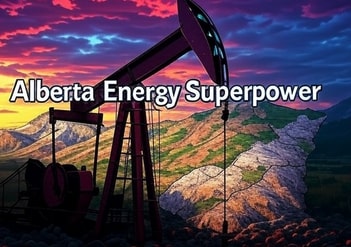Now Reading: Alberta Could Hold Independence Referendum Late in 2025 – Become an Energy Superpower
-
01
Alberta Could Hold Independence Referendum Late in 2025 – Become an Energy Superpower
Alberta Could Hold Independence Referendum Late in 2025 – Become an Energy Superpower

The Alberta Premier has made it easier for citizens to collect enough signatures to put the question of Alberta Independence to a vote. Polling has indicated about 30% support for Alberta independence but polling may not be accurate.
Collecting the signatures to have a vote should be relatively easy. The hard part will be actually winning the vote to then get to negotiations for independence. However, independence for Alberta is very economically attractive, especially based upon current conditions where US cooperation is guaranteed. This would put Alberta into a far better negotiating position with Ontario, Quebec and Canada.
If the Liberals and the Prime Minister continued the previous administrations anti-pipeline, anti-energy policies like carbon taxes then this would run counter to the demands of Alberta. A hardline against Alberta would mean Canada shoving Alberta out of Canada.
Alberta and Saskatchewan voted 65% for conservatives and both have energy (oil and gas) inside the provinces that would be better developed out of Canada’s restrictions. BC also has a lot of natural gas but the majority of BC population is currently less interested in developing those resources. If Alberta did leave and was successful then it would attract Saskatchewan, the three northern territories and eventually BC could also want the same terms where they could be 50% or even 100% richer per person over time. It would start as an ABExit and could become a CanWestExit.
History of polling did show a strong lead but conservatives never had more than about 44-45% support. Liberal support collapsed until enough people in Canada hated Trump and the US more than they hated the Liberals.

Canada is 58% left and 42% conservative. All of the Bloc, NDP and Green parties got less votes to consolidate left votes into the Liberals.
Current Alberta Economy Baseline
GDP: Alberta’s GDP is approximately $350 billion, based on historical data adjusted to recent years (e.g., $331.9 billion in 2016, grown modestly with inflation and economic trends).
Population: Alberta’s population is around 4.5 million.
Per Capita GDP: $350 billion ÷ 4.5 million = ~$77,778 per person.
Oil Production: Currently 4.3 million barrels per day (bpd).
Natural Gas Production: 11.2 billion cubic feet per day (Bcf/d) in 2023.
Fiscal Contribution: Alberta is a net contributor to Canada’s federal system, transferring approximately $25 billion annually more to federal revenues than it receives in spending (a rough average based on historical net fiscal transfers).
Currently, Alberta is a resource-rich province within Canada, heavily reliant on its oil and gas sector (contributing ~25% of GDP), but its economic policies and fiscal transfers are constrained by federal oversight.
Alberta has aspirations to become an energy super power. If there was no Federal Canada (Ottawa-Ontario and Quebec) constraining Alberta, then Alberta could double oil production in about 5 years. They could send five pipelines into Montana and increase natural gas production.
The AI data center boom will be natural gas powered.
Increased Oil Impact
Revenue Estimate: At $70 per barrel (a 2024 price estimate):
Current: 4.3 million bpd × 365 × $70 = ~$110 billion annually.
Doubled: 9 million bpd × 365 × $70 = ~$230 billion.
Increase: $120 billion in revenue.
GDP Contribution: GDP reflects value added (revenue minus costs). If oil sands contribute ~$35 per barrel to GDP (derived from $38 billion for 1.095 billion barrels annually), then:
Current: 4.3 million bpd × 365 × $35 = ~$55 billion.
Doubled: 9 million bpd × 365 × $35 = ~$115 billion.
Increase: $115 billion – $55 billion = $60 billion.
Adjusted Estimate: Scaling the $55 billion contribution by 109% yields ~$115 billion, aligning with the per-barrel method. Thus, GDP increases by ~$70 billion (using a slightly higher estimate from proportional scaling to Canadian GDP impacts, adjusted for Alberta’s focus).
New GDP: $350 billion + $70 billion = $420 billion.
Separation from Canada and Equalization Savings
Alberta currently contributes ~$25 billion net annually to Canada (federal taxes exceeding federal spending received). Equalization itself is funded from federal revenues, not directly from provinces, but Alberta’s high fiscal capacity means it effectively subsidizes other regions.
Separation Impact: As a sovereign entity, Alberta retains this $25 billion. While not directly added to GDP (which measures production), this fiscal saving could be reinvested into the economy (e.g., infrastructure, tax cuts), potentially boosting GDP indirectly.
Conservative Estimate: Assume this amplifies economic activity modestly, adding ~$25 billion to GDP over time via a multiplier effect (simplified as direct retention for this scenario).
Updated GDP: $420 billion + $25 billion = $445 billion.
Natural Gas-Powered AI Data Centers
Alberta can build 30-50 gigawatts (GW) of natural gas-powered AI data centers.
Construction Costs:
Power Plants: 30 GW at $1 million/MW = $30 billion (assuming 60 × 500 MW plants).
Data Centers: 30 GW (30,000 MW) at $10-15 million/MW = $300-450 billion.
Total: ~$400 billion over, say, 5 years = $80 billion/year during construction.
Operational Impact: Once built, data centers consume 30-50 GW and contribute via jobs, power purchases, and AI business activity.
Electricity cost at $0.05/kWh for 30 GW: 30 million kWh/hour × $0.05 × 8760 hours = ~$13 billion/year.
Total operational GDP (jobs, maintenance, etc.): Assume ~$50 billion/year, reflecting local economic activity.
GDP Boost: $80 billion/year during construction (5 years), then $50 billion/year ongoing. Post-construction, add $50 billion to the baseline.
Final GDP: $445 billion + $50 billion = $495 billion.
Per Capita GDP
Population: Remains 4.5 million (assuming no major change post-separation).
New Per Capita GDP: $495 billion ÷ 4.5 million = ~$110,000.
Compared to the current $77,778, this is a ~41% increase, reflecting massive economic growth.
Energy Capacity as a “Free Energy Super Power”
Natural Gas Demand:
30 GW requires ~5 Bcf/d (168 million cf/day per GW × 30), 50 GW requires ~8.4 Bcf/d.
Current production: 11.2 Bcf/d (2023). For 30 GW, total demand rises to 16.2 Bcf/d; for 50 GW, 19.6 Bcf/d.
Increase Needed: 45-75% over current levels, achievable with investment (projections suggest 11.6 Bcf/d by 2033 without this push).
Oil Production: 9 million bpd makes Alberta a top-tier oil producer globally (e.g., rivaling Saudi Arabia’s ~10 million bpd).
Energy Profile: With abundant oil (9 million bpd) and natural gas (16-20 Bcf/d), Alberta could offer low-cost energy, attracting energy-intensive industries (e.g., AI, manufacturing).

If Alberta doubles oil production to 9 million bpd, separates from Canada (saving $25 billion in transfers), and builds 30-50 GW of natural gas-powered AI data centers (adding $50 billion annually from $2 trillion in business activity), its GDP could rise from $350 billion to ~$495 billion. Per capita GDP would increase from $77,778 to ~$110,000. With oil at 9 million bpd and natural gas at 16-20 Bcf/d, Alberta could emerge as an energy super power.

Brian Wang is a Futurist Thought Leader and a popular Science blogger with 1 million readers per month. His blog Nextbigfuture.com is ranked #1 Science News Blog. It covers many disruptive technology and trends including Space, Robotics, Artificial Intelligence, Medicine, Anti-aging Biotechnology, and Nanotechnology.
Known for identifying cutting edge technologies, he is currently a Co-Founder of a startup and fundraiser for high potential early-stage companies. He is the Head of Research for Allocations for deep technology investments and an Angel Investor at Space Angels.
A frequent speaker at corporations, he has been a TEDx speaker, a Singularity University speaker and guest at numerous interviews for radio and podcasts. He is open to public speaking and advising engagements.























